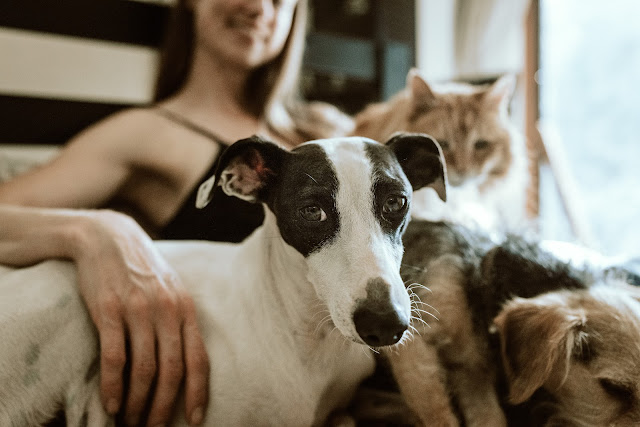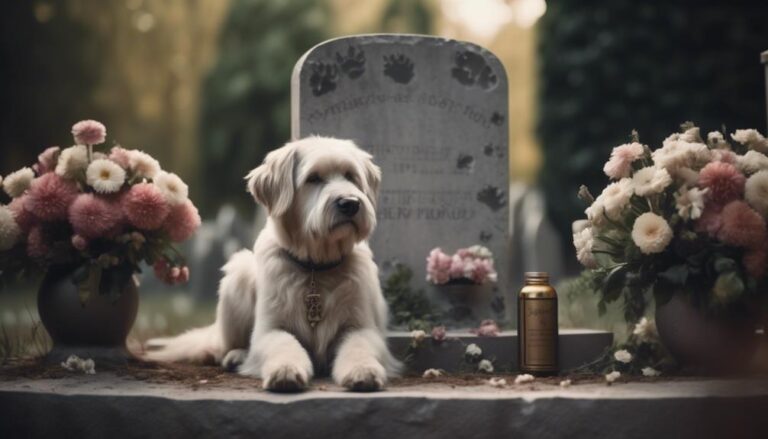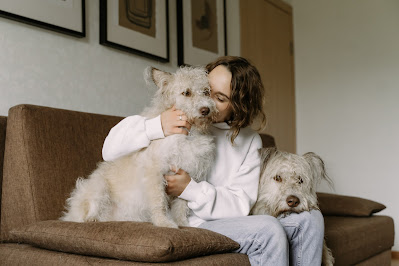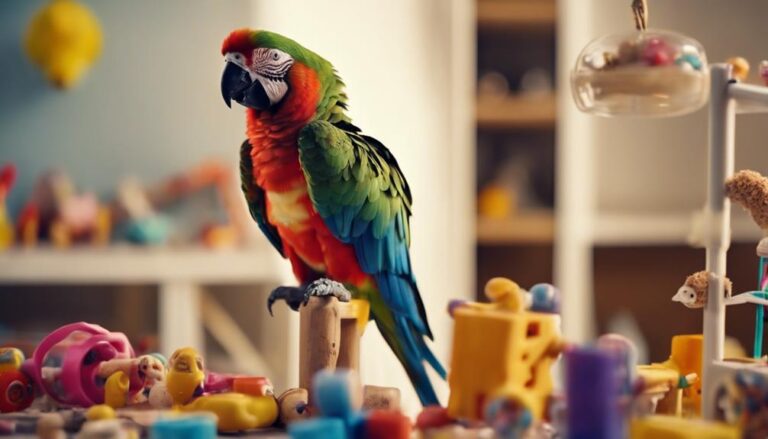Furry Frenemies: The Dynamic Between Dogs And Cats

The Dynamic Between Dogs And Cats: The evolutionary background of dogs and cats significantly influences their behavior and interactions with one another. Over thousands of years, dogs and cats have coexisted, and their instincts and behaviors have been shaped by their roles as predators and prey in the wild.
Dogs, descendants of wolves, exhibit a pack mentality and hunting instincts. This can affect their response to cats, as they may see them as potential prey or competition for resources. Dogs may chase or exhibit predatory behavior towards cats, especially if they are not properly socialized or trained. On the other hand, cats have a solitary and cautious nature. They are naturally inclined to be wary of potential threats, including dogs. Cats may display defensive behaviors such as hissing, scratching, or retreating when faced with a dog’s presence.
The domestication process has also played a role in shaping the dynamics between dogs and cats. Dogs have been selectively bred for their social behaviors and ability to work cooperatively with humans. This can make them more adaptable to living with cats and other animals. Cats, on the other hand, have a more independent nature and may require more time and effort to adjust to living with dogs.
Understanding the evolutionary background of dogs and cats provides insights into their natural tendencies and helps in managing their interactions in a household setting. It is important to provide proper socialization, training, and a safe environment for both dogs and cats to ensure harmonious coexistence. By recognizing and respecting their innate instincts, we can create a peaceful environment where dogs and cats can live together in harmony.
Instinctual Behaviors and Communication
Understanding the instinctual behaviors and communication patterns of dogs and cats is crucial for fostering a harmonious relationship between these two species. These behaviors and communication styles are deeply rooted in their evolutionary history. Dogs, as descendants of wolves, have retained their hunting instinct, which can sometimes be triggered when they interact with cats. Cats, on the other hand, have evolved as solitary hunters, which influences their defensive mechanisms when faced with perceived threats.
Communication between dogs and cats is primarily non-verbal. They use body language, vocalizations, and scent marking to convey messages to one another. For example, a dog wagging its tail is often seen as a friendly gesture, while a cat with an arched back and hissing is displaying defensive behavior. Dogs rely heavily on scent marking to communicate with other animals, including cats. They leave behind pheromones through urine marking, which can convey information about their territory, social status, and availability for mating.
Understanding and interpreting these communication cues is essential for pet owners to facilitate positive interactions between their dogs and cats. By observing their body language and vocalizations, you can gauge their comfort level and intervene if necessary. It is important to recognize and respect their individual instincts and communication styles. This means providing them with separate spaces, such as designated areas for eating and sleeping, to avoid potential conflicts. Additionally, providing opportunities for socialization and positive reinforcement training can help them develop trust and understanding towards one another.
Understanding Body Language Cues
Understanding body language cues is crucial when it comes to fostering a harmonious dynamic between dogs and cats. Paying attention to subtle cues like tail position and eye contact can provide valuable insights into their intentions and emotions. A wagging tail can indicate friendliness in dogs, while eye contact can serve as a form of communication between cats. By understanding these cues, you can navigate their interactions more effectively and prevent potential conflicts.
Tail Position and Meaning
Tail position is a key indicator of emotions and intentions in both dogs and cats. Evolutionary origins have shaped the significance of tail positions in nonverbal communication among these animals. Understanding the meanings behind different tail positions can help pet owners interpret their furry friends’ emotions accurately.
In dogs, a raised, wagging tail often signifies excitement or happiness. This tail position is a result of evolutionary adaptations that allow dogs to communicate their positive emotions to others. On the other hand, a tucked tail in a dog can indicate fear or submission. This is a way for dogs to show their vulnerability and avoid confrontation.
In cats, an erect tail suggests confidence or a friendly demeanor. This tail position is a sign that the cat is comfortable and open to interaction. Conversely, a puffed-up tail can signal fear or aggression. Cats puff up their tails to appear larger and more threatening when they feel threatened or defensive.
Understanding these tail positions can be useful in behavioral training and in creating a harmonious environment for both dogs and cats. By recognizing these nonverbal cues, pet owners can better understand their furry friends’ emotions and foster a positive dynamic between them.
Eye Contact and Communication
Now let’s shift our focus to another important aspect of nonverbal communication between dogs and cats: eye contact and its role in their communication dynamics. Dogs and cats have evolved different ways of using eye contact to convey their intentions and emotions. For cats, direct eye contact can be a sign of trust or a challenge, while dogs may interpret it as a threat or an invitation to play.
On the other hand, an averted gaze in cats can signal fear or submission, while in dogs it can indicate relaxation or avoidance of conflict. Understanding these nonverbal cues is crucial in preventing misunderstandings and conflicts between dogs and cats. By paying attention to their body language, you can facilitate better communication and build trust between these furry frenemies.
Introducing Dogs and Cats: Tips and Tricks
When introducing dogs and cats, there are several key points to keep in mind. Firstly, a successful meet and greet is crucial, allowing the animals to become familiar with each other’s presence in a controlled environment. Secondly, establishing boundaries is essential to prevent any potential aggression or territorial conflicts. Lastly, creating positive interactions, such as supervised play sessions and rewarding good behavior, can help foster a harmonious relationship between dogs and cats. By following these tips and tricks, you can increase the chances of a successful introduction and create a peaceful dynamic between your furry friends.
Successful Meet and Greet
To successfully introduce dogs and cats, it is crucial to follow proper socialization and training techniques. This is especially important when introducing puppies to cats, as it sets the foundation for a positive and harmonious relationship. Managing anxiety is key during the meet-and-greet process. Both dogs and cats may feel apprehensive or fearful when meeting each other for the first time.
It is important to create a calm and controlled environment to help alleviate their anxiety. Building trust is another essential aspect of a successful introduction. Gradually introducing them to each other’s scent and allowing them to interact under supervision can help foster trust and familiarity. Remember, a successful meet and greet is not just about a pleasant first encounter, but also about laying the groundwork for a lasting friendship between dogs and cats.
Establishing Boundaries
After successfully managing the meet and greet between your dog and cat, the next crucial step is establishing boundaries to ensure a harmonious coexistence. Training techniques play a vital role in teaching your pets how to interact with each other appropriately. For dogs, use positive reinforcement to reward calm behavior around the cat and discourage any chasing or aggressive tendencies.
This can include treats, praise, and clicker training. Setting limits is also essential. Create designated areas where each pet can retreat to, providing them with their own space and ensuring they feel safe. Additionally, establishing routines can help both pets understand what is expected of them. Consistency in feeding, walking, and playtime can create a sense of structure and stability, reducing potential conflicts. By implementing these strategies, you can help your dog and cat establish healthy boundaries and foster a peaceful coexistence.
Creating Positive Interactions
Properly introducing dogs and cats is crucial for creating positive interactions and fostering a harmonious relationship between them. Managing aggression, building trust, and promoting cooperation are essential steps in this process. First, it is important to supervise their initial encounters to prevent any aggressive behavior or potential harm.
Gradually increase the duration of their interactions as they become more comfortable with each other. Building trust is key to their relationship, so provide positive reinforcement and rewards when they exhibit calm and friendly behavior. Encourage cooperation by engaging them in activities that they both enjoy, such as playing with toys or going on walks together. Remember, each dog and cat is unique, so be patient and adapt your approach accordingly. By following these strategies, you can help dogs and cats establish a positive bond and create a harmonious living environment.
Establishing Boundaries in a Multi-Pet Household
Establishing boundaries in a multi-pet household is crucial for maintaining a harmonious dynamic between dogs and cats. Training techniques, managing resources, and handling aggression are key factors in creating a peaceful coexistence between your furry friends.
One effective training technique is to clearly designate separate areas for each pet to eat, sleep, and have alone time. This helps prevent any potential conflicts over resources and territory. You can use baby gates or pet barriers to create boundaries and safe spaces for each pet. This allows them to have their own personal areas while still being able to see and interact with each other.
In addition to physical boundaries, it’s important to train your pets to respect each other’s spaces and belongings. Positive reinforcement is a valuable tool for teaching them proper behavior. Reward them with treats, praise, or playtime when they show respect and follow the rules. This helps them understand what is expected of them and reinforces positive interactions.
Supervising initial interactions between your pets is crucial. Start with short, controlled interactions and gradually increase the amount of time they spend together. This allows them to get used to each other’s presence and establish a sense of familiarity. It’s important to intervene and redirect any signs of aggression or tension, ensuring a safe and positive environment for all.
Lastly, providing individual attention and playtime is essential. This prevents feelings of competition and jealousy, as each pet receives their fair share of love and attention. Spend quality time with each pet separately, engaging in activities they enjoy. This helps build their confidence, strengthens the bond between you and your pet, and reduces any potential conflicts.
Common Challenges and Potential Solutions
To ensure a harmonious relationship between dogs and cats, it is important to address the common challenges that may arise and find potential solutions that promote a peaceful coexistence. One such challenge is managing aggression in dogs. Dogs have a natural hunting instinct that may trigger a chase response towards cats. To mitigate this, it is crucial to provide dogs with appropriate exercise and mental stimulation to redirect their energy. Engaging them in activities such as fetch or puzzle toys can help satisfy their instincts and reduce their desire to chase after cats.
On the other hand, cats may exhibit caution and fear when introduced to dogs. To build trust and minimize potential conflicts, it is essential to create safe spaces and vertical territory for cats to retreat to when needed. This can include providing elevated perches or cat trees where they feel secure. Additionally, gradually introducing cats to the dog in a controlled manner, using positive reinforcement techniques, can help them associate the dog’s presence with positive experiences. Offering treats and praise when they are calm and relaxed around the dog can help foster a sense of security and trust.
Resolving territorial conflicts is another common challenge. Providing separate resources such as food, water, and litter boxes for dogs and cats can reduce competition and prevent conflicts. Each pet should have their own designated area where it can eat and use the bathroom without feeling threatened or interrupted by the other.
In cases where challenges persist, seeking professional guidance from a veterinarian or animal behaviorist is recommended. They can assess the specific needs and behaviors of the pets and develop a customized plan for integration. With patience, consistency, and the right strategies, dogs and cats can learn to coexist peacefully and form a bond that enriches both their lives.
The Role of Socialization in Building Positive Relationships
To build positive relationships between dogs and cats, early life experiences are crucial. By introducing them at a young age, they can develop a mutual understanding and view each other as potential playmates. Positive reinforcement techniques, such as rewarding desired behaviors, can further enhance their bond and create a harmonious dynamic.
Early Life Experiences
Early life experiences play a crucial role in shaping the dynamics and potential conflicts between dogs and cats, as proper socialization during this critical period is key to building positive relationships. The importance of early socialization cannot be overstated. Dogs and cats that are introduced to each other at a young age are more likely to develop a bond and view each other as companions rather than adversaries.
Well-socialized animals tend to respond to each other with curiosity and acceptance, rather than fear or aggression. On the other hand, negative early experiences can have lasting impacts on their relationship. Traumatic encounters or lack of exposure to each other during the early stages of life can lead to distrust, fear, and even aggression. Therefore, it is crucial to provide puppies and kittens with opportunities for positive interactions, allowing them to learn appropriate social behaviors and build a foundation for harmonious relationships in the future.
Mutual Understanding Cues
Building on the importance of early socialization, the role of mutual understanding cues in building positive relationships between dogs and cats cannot be overlooked. Understanding body language is crucial for both dogs and cats to communicate effectively. Dogs use tail wagging, relaxed body postures, and play bows to signal friendliness and invitation to play. Cats, on the other hand, may show interest by approaching with a relaxed body, slow blinking, and tail held high.
It is essential to establish boundaries and give each pet their own space to feel safe and secure. By promoting positive interactions, such as supervised play sessions and rewarding calm behavior, dogs and cats can learn to coexist harmoniously. Mutual understanding cues create a foundation of trust and respect, fostering a healthy and balanced relationship between dogs and cats.
Positive Reinforcement Techniques
Using positive reinforcement techniques is crucial in fostering positive relationships between dogs and cats, as it encourages friendly interactions and helps create a bond based on comfort and familiarity. Rewards and praise play a significant role in promoting companionship between these two species. By consistently rewarding desirable behavior, such as calm interactions and respectful boundaries, dogs and cats can learn to associate each other’s presence with positive experiences.
Understanding body language is also essential in using positive reinforcement effectively. By recognizing signs of fear or discomfort in either the dog or the cat, you can intervene appropriately and create a safe environment for both animals. Through positive reinforcement, dogs and cats can learn to view each other as companions rather than competitors, ultimately building a harmonious and loving relationship.
Promoting Playful Interactions Between Dogs and Cats
To foster playful interactions between dogs and cats, it is crucial to establish positive relationships through proper socialization and training. Playtime strategies play a vital role in encouraging cooperation and building trust between these furry frenemies. When introducing dogs and cats, it is important to do so at a young age. This allows them to view each other as potential playmates rather than rivals. By facilitating supervised play sessions, you can ensure that both animals feel safe and comfortable in each other’s presence.
During playtime, it is essential to provide a controlled environment where both the dog and cat have enough space to move around without feeling threatened. Start with short and supervised play sessions, gradually increasing the duration as they become more comfortable with each other. Be sure to offer toys and activities that engage both animals, such as interactive play mats or puzzle toys that require their joint effort. This will help them associate positive experiences with each other’s presence.
Encouraging cooperation between dogs and cats during play involves rewarding desired behaviors and redirecting any negative or aggressive tendencies. Use positive reinforcement techniques such as treats, praise, and affection to reinforce good behavior. For example, reward the dog for staying calm and gentle around the cat, or reward the cat for approaching the dog without fear. This will create a positive association and motivate them to continue engaging in playful interactions.
Building trust between dogs and cats takes time and patience. Allow them to interact at their own pace and never force them into uncomfortable situations. Observe their body language and intervene if any signs of tension or aggression arise. By respecting their individual personalities and needs, you can help them build a foundation of trust and understanding.
Overcoming Preconceived Notions and Stereotypes
Overcoming preconceived notions and stereotypes is crucial for fostering a positive and harmonious relationship between dogs and cats. It is important to challenge the misconceptions that often surround their interactions and approach their dynamic with an open mind. Dogs and cats have long been considered natural enemies, but changing perspectives and breaking stereotypes can lead to surprising outcomes.
One common misconception that needs to be debunked is the idea that dogs and cats will automatically clash. While it is true that they have different communication styles and socialization needs, it does not mean they cannot coexist peacefully. By understanding that individual personalities and socialization play a significant role in their dynamic, we can avoid making assumptions about their behavior and instead create an environment where they have the opportunity to form positive bonds.
Changing our perspective involves recognizing that not all cats and dogs will fit the stereotypes often associated with their species. Some cats may be more outgoing and social, while some dogs may be more gentle and laid-back. By embracing these individual differences, we can better manage their interactions and foster a more harmonious relationship.
Breaking stereotypes also means avoiding generalizations about their behavior. Just because a dog may have a strong prey drive or a cat may be more territorial, it does not mean they cannot learn to coexist peacefully. With proper training, socialization, and supervision, dogs and cats can learn to respect each other’s boundaries and even engage in playful interactions.
Nurturing a Lifelong Bond Between Dogs and Cats
Understanding the importance of nurturing a lifelong bond between dogs and cats is key to fostering a positive and harmonious relationship between these two species. When introducing dogs and cats, it is important to follow a few tips to ensure a smooth transition. First, allow them to smell each other’s scent by swapping bedding or toys before the initial meeting. This will help them become familiar with each other’s presence. Next, provide a safe and neutral space for the first introduction, such as a separate room or a large enclosed area. This will prevent territorial conflicts and allow them to interact on their own terms.
During the initial meeting, it is crucial to closely supervise their interaction and intervene if necessary. Keep the dog on a leash and allow the cat to approach at its own pace. Reward both animals with treats and praise for calm and positive behavior. This will build trust and confidence between them.
In the early stages, it is important to manage conflicts between dogs and cats. If either animal shows signs of aggression or fear, separate them and consult with a professional trainer or behaviorist. Gradual exposure and positive reinforcement training can help them overcome any issues and develop a bond based on trust and mutual respect.
Remember that every dog and cat is unique, and the dynamics between them will vary. Some dogs may have a strong prey drive, while others may be more tolerant. Similarly, some cats may be more accepting of dogs, while others may be more cautious. Patience, consistency, and positive reinforcement are key in building a lifelong bond between dogs and cats.
The Dynamic Between Dogs And Cats Frequently Asked Questions
Why Are Cats and Dogs Seen as Enemies?
Cats and dogs are seen as enemies due to a misunderstood bond. Cultural perceptions and coexistence challenges contribute to this perception. However, with proper understanding and training, they can coexist harmoniously and even develop a strong bond.
Why Do Cats Antagonize Dogs?
Cats antagonize dogs for various reasons. Their playful instigation, territorial behavior, and prey instinct can all contribute to this dynamic. Understanding these factors helps us better comprehend the complex relationship between cats and dogs.
Why Are Cats and Dogs Rivals?
Cats and dogs are rivals due to their natural instincts, territorial behavior, and different communication styles. These factors can create tension and misunderstandings, but with proper understanding and training, they can learn to coexist peacefully.
What Are the Traits of Dogs Vs Cats?
Dogs are known for their loyalty and trainability, while cats are often independent and stubborn. Dogs tend to be more playful and expressive, while cats can be aloof. Understanding these traits can help in fostering positive relationships between them.
Conclusion
In conclusion, the dynamic between dogs and cats is complex and varies from pet to pet. Understanding their evolutionary backgrounds, instinctual behaviors, and communication cues can help pet owners navigate their interactions. By introducing them properly, establishing boundaries, and promoting positive socialization, dogs and cats can coexist peacefully and even develop lifelong bonds. It’s important to approach their relationship with patience, training, and a willingness to challenge preconceived notions and stereotypes. With the right approach, furry frenemies can become the best of friends.








